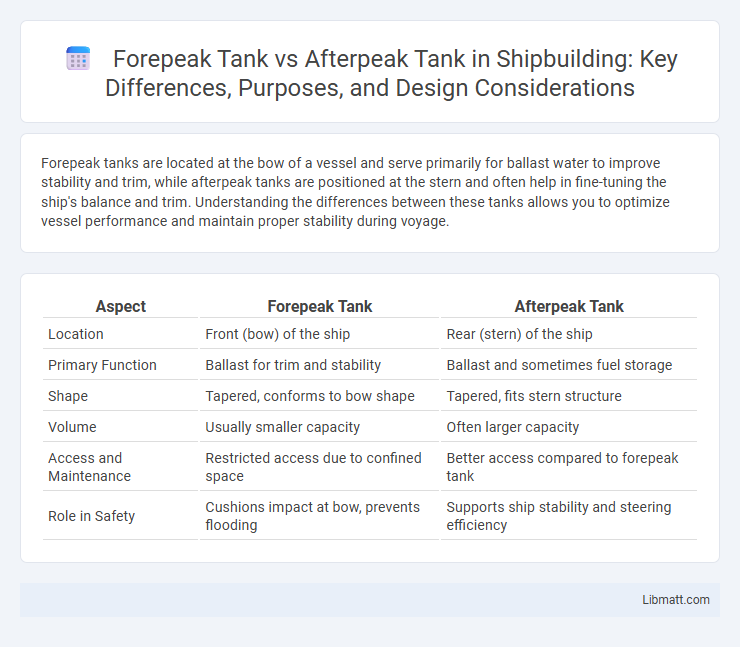Forepeak tanks are located at the bow of a vessel and serve primarily for ballast water to improve stability and trim, while afterpeak tanks are positioned at the stern and often help in fine-tuning the ship's balance and trim. Understanding the differences between these tanks allows you to optimize vessel performance and maintain proper stability during voyage.
Table of Comparison
| Aspect | Forepeak Tank | Afterpeak Tank |
|---|---|---|
| Location | Front (bow) of the ship | Rear (stern) of the ship |
| Primary Function | Ballast for trim and stability | Ballast and sometimes fuel storage |
| Shape | Tapered, conforms to bow shape | Tapered, fits stern structure |
| Volume | Usually smaller capacity | Often larger capacity |
| Access and Maintenance | Restricted access due to confined space | Better access compared to forepeak tank |
| Role in Safety | Cushions impact at bow, prevents flooding | Supports ship stability and steering efficiency |
Introduction to Forepeak and Afterpeak Tanks
Forepeak tanks and afterpeak tanks are specialized compartments located at the bow and stern of a ship, respectively, serving crucial roles in ballast management and structural integrity. Forepeak tanks primarily stabilize the vessel during loading and unloading by accommodating water ballast at the front, while afterpeak tanks perform a similar function at the ship's rear, contributing to trim and balance adjustments. Both tanks optimize weight distribution, enhance vessel stability, and support smooth navigation in varying sea conditions.
Definition and Location of Forepeak Tank
A forepeak tank is a ballast tank located at the forward-most part of a ship's hull, situated ahead of the collision bulkhead. Its primary function is to improve the vessel's stability and trim by adjusting water ballast and preventing hull damage in case of collision. Positioned at the bow, this tank contrasts with the afterpeak tank, which is located at the stern of the ship.
Definition and Location of Afterpeak Tank
The afterpeak tank is a compartment located at the aftmost part of a ship, typically situated at the stern below the main deck. It is primarily used for ballast water or liquid cargo storage, contributing to the vessel's stability and trim management. Unlike the forepeak tank found at the bow, the afterpeak tank balances weight distribution at the rear, preventing excessive stern sag and enhancing navigational safety.
Functional Differences Between Forepeak and Afterpeak Tanks
Forepeak tanks primarily provide ballast to improve the ship's stability and trim by counteracting bow-heavy conditions, while afterpeak tanks mainly serve to balance stern weight and maintain proper trim during varying cargo loads. The forepeak tank often stores fresh or ballast water, aiding in forward buoyancy, whereas the afterpeak tank accommodates ballast water critical for preventing rudder cavitation and enhancing propulsion efficiency. Functional differences include their distinct roles in managing longitudinal stability and influencing the vessel's handling characteristics under different sea conditions.
Structural Role in Ship Stability
Forepeak tanks, located at the bow, and afterpeak tanks, situated at the stern, both play critical roles in a ship's structural integrity and stability by managing ballast water to maintain proper trim and prevent excessive stresses on the hull. These tanks help counteract pitching motions and improve longitudinal strength, ensuring even weight distribution that enhances overall vessel balance and seaworthiness. Your understanding of their distinct placement and function supports optimizing load management and improving stability during navigation.
Typical Uses and Stored Contents
Forepeak tanks are typically used for ballast water or fresh water storage to maintain the ship's trim and stability, frequently positioned at the bow to absorb impact forces. Afterpeak tanks, located at the stern, often store ballast water to enhance directional stability and counterbalance the weight of aft machinery or cargo. Both tanks are essential in managing vessel balance during loading, unloading, and varying sea conditions.
Impact on Ballast and Trim Adjustment
Forepeak tanks, located at the forward end of a vessel, play a crucial role in improving trim by adding weight to the bow, which helps balance the ship when the bow is too light. Afterpeak tanks, positioned at the stern, assist in adjusting the trim by adding weight to the aft, counteracting a heavy bow or uneven cargo distribution. Managing ballast in both tanks allows precise control over a vessel's trim, ensuring stability, fuel efficiency, and optimal navigational performance.
Maintenance Considerations for Peak Tanks
Forepeak tanks typically require more frequent inspection due to their exposure to sea conditions and potential for corrosion at the bow, demanding rigorous maintenance protocols such as cleaning, coating, and corrosion control. Afterpeak tanks, located at the stern, are also prone to contamination from machinery spaces and require regular monitoring for oil and sludge accumulation to prevent contamination. Both tanks necessitate diligent maintenance strategies including routine draining, inspection for structural integrity, and adherence to marine safety regulations to ensure optimal performance and longevity.
Safety Features and Regulations
Forepeak tanks and afterpeak tanks are critical for a vessel's stability and buoyancy but differ significantly in safety features and regulations due to their locations. Forepeak tanks, located at the bow, often require enhanced corrosion protection and structural reinforcements to withstand impacts and comply with maritime safety standards such as SOLAS and MARPOL. Your ship's afterpeak tank must adhere to stringent construction and maintenance regulations to prevent contamination and ensure proper ballast management, minimizing environmental risks and maintaining compliance with international maritime laws.
Comparative Pros and Cons of Forepeak vs Afterpeak Tanks
Forepeak tanks, located at the bow, enhance vessel balance during rough seas by providing additional buoyancy, but they are more susceptible to damage from collisions and require extra maintenance. Afterpeak tanks, positioned at the stern, improve trim control and stability under heavy loads, yet they often reduce available cargo space and may increase vulnerability to aft impacts. Selecting between forepeak and afterpeak tanks depends on factors like vessel design, operational requirements, and balance optimization.
Forepeak tank vs afterpeak tank Infographic

 libmatt.com
libmatt.com